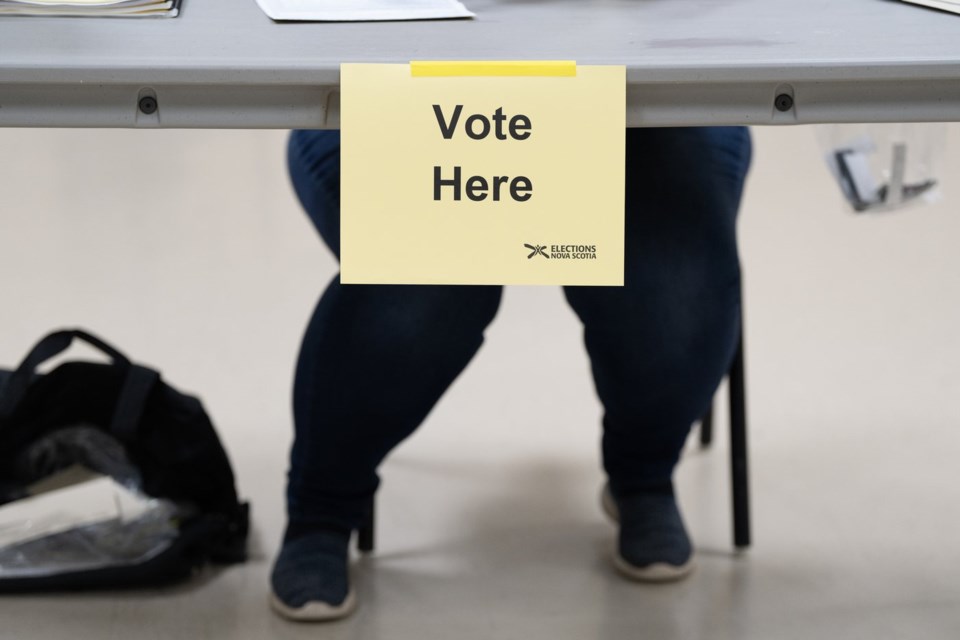HALIFAX — The weak voter turnout in Nova Scotia’s election is "shocking" but not a complete surprise, says a political scientist after almost 66,000 fewer voters cast ballots compared with the 2021 vote.
Unofficial data from Elections Nova Scotia indicates that 357,048 — or 45 per cent — of 788,427 eligible voters turned out to the polls for the general election that gave Tim Houston’s Progressive Conservatives their second consecutive majority. Election day was Tuesday.
That’s down 10 per cent from the 2021 provincial election when 422,712 Nova Scotians cast ballots.
Alex Marland, a professor and political scientist at Acadia University in Wolfville, N.S., said in an interview Thursday that the voting numbers are disappointing, and he called for measures to bring citizens back to the polls.
“This is shocking and frustrating and disturbing given that the last election (in 2021) occurred when there was still a lot of social distancing still occurring and people were fearful of things because of COVID,” he said.
Marland said the snap election call on the heels of the United States presidential election, a lack of drama and polarization during the campaign period, and the decline in local media all contributed to less voter engagement.
“It’s a real recipe for lower involvement, lower awareness,” he said, adding that opposition parties were particularly disadvantaged by the short notice to generate election readiness for their campaigns, in the media and among voters.
Another notable concern for Marland was Elections Nova Scotia’s “baffling” decision not to send voter information cards when the election was called. The provincial elections agency said the decision was based on the threat of a strike by Canada Post workers.
The agency launched a media campaign to share information about voting locations, using the internet and traditional advertising.
“I’m of the strong opinion they should have forged ahead (with the paper voting cards) regardless,” Marland said.
The decision not to mail cards was also criticized by Bill VanGorder, a spokesperson for the Canadian Association of Retired Persons. He said many seniors don’t use the internet regularly and had relied on the postal service to receive information about voting.
Seniors usually make up a significant part of voters. Data from Elections Nova Scotia from the 2021 election say people over 65 made up 35 per cent of total voters, despite being just 28 per cent of the total electorate.
Though his group has yet to complete its survey on how many seniors in the province voted, VanGorder said the absence of voter information cards “confused a lot of seniors,” adding that his initial conversations with older Nova Scotians after the election led him to believe there was a decline in senior participation.
Marland said voter cards and other means of generating awareness about an election are also important, particularly for "low-interest voters," often composed of renters, young people, low-income earners and people who might not pay attention to politics.
These voters usually “only start paying attention once a debate (happens) or when there is a lot of media coverage and they can’t avoid it,” Marland said. He added these folks are less likely to vote when public opinion polls predict that one party is far ahead, as was the case for the Nov. 26 election.
Nova Scotia’s election had the lowest voter turnout in all four of Canada's provincial elections this year, followed by October elections in Saskatchewan with 56 per cent turnout, British Columbia with 58 per cent turnout, and New Brunswick with 66 per cent.
Marland said it's difficult to compare provinces, but he said elections with contentious issues or a fresh slate of political leaders usually motivate higher turnout.
During Nova Scotia's campaign, polls gave the Progressive Conservatives a dominant lead over the Liberals and NDP, which Marland said didn’t give “as much motivation for people to feel that their vote mattered.”
When asked what a healthy level of democratic engagement looks like, Marland said instead of looking at mere numbers it’s better to look at an upward trend from election to election.
“The bottom line is if the trend is going down, there’s a problem and something needs to be done about it.”
This report by The Canadian Press was first published Nov. 28, 2024.
Cassidy McMackon, The Canadian Press




